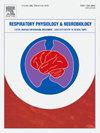Ventilatory response and dyspnea on exertion in children with obesity and respiratory symptoms
IF 1.6
4区 医学
Q3 PHYSIOLOGY
引用次数: 0
Abstract
We investigated whether the exercise ventilatory response is associated with dyspnea on exertion (DOE) in children with (CWO;n = 25) and without (CWOO;n = 49) obesity, and with obesity and respiratory symptoms (CWORS;n = 14). The ventilatory response to exercise (V̇E/V̇CO2 slope) and ratings of perceived breathlessness (RPB, Borg 0–10 scale) were measured during 6-min cycling at 45 % maximal work rate. The V̇E/V̇CO2 slope (CWOO=34 ± 7; CWO=34 ± 5; CWORS=37 ± 6) and RPB (CWORS=4.0 ± 3.4; CWOO=2.5 ± 1.7; CWO=3.2 ± 2.1) were similar among groups (p > 0.05). A significant association between the V̇E/V̇CO2 slope and RPB in CWORS (r2=0.49;p < 0.05) was observed. To investigate this relationship more closely, children with an RPB≤ 2 were classified as having no or mild DOE (-DOE;n = 39;RPB=1.2 ± 0.7), and those with RPB≥ 3 were classified as having moderate to severe DOE (+DOE;n = 49;RPB=4.7 ± 1.9). +DOE had a higher V̇E/V̇CO2 slope (+DOE=36 ± 6;-DOE=33 ± 5;p = 0.02), higher breathing frequency, and higher V̇E (%max;p < 0.05). These findings suggest a heightened sensitivity to ventilatory demand among children, and that +DOE may be driven by factors other than obesity alone, possibly increased ventilatory response to exercise.
肥胖和呼吸症状患儿用力时的呼吸反应和呼吸困难
我们调查了患有(CWO;n = 25)和没有(CWOO;n = 49)肥胖以及肥胖和呼吸道症状(CWORS;n = 14)的儿童的运动通气反应是否与用力时呼吸困难(DOE)相关。在45 %最大工作速率下骑行6分钟,测量运动通气反应(V / E/V / CO2斜率)和感知呼吸困难评分(RPB, Borg 0-10评分)。V (E) /V (CO2)斜率(CWOO=34 ± 7;CWO = 34 ± 5;CWORS=37 ± 6)和RPB (CWORS=4.0 ± 3.4;CWOO = 2.5 ± 1.7;CWO=3.2 ± 2.1)组间差异无统计学意义(p >; 0.05)。CWORS的V (E) /V (CO2)斜率与RPB之间存在显著相关性(r2=0.49;p <; 0.05)。探讨这种关系更密切,孩子离≤ 2被归类为没有或轻微能源部(DOE; n = 39;强化= 1.2 ±0.7 ),和那些离≥ 3被划分中度到重度的DOE(+能源部;n = 49;强化= 4.7 ±1.9 )。+DOE具有较高的V (E) /V (E) / CO2斜率(+DOE=36 ± 6;-DOE=33 ± 5;p = 0.02)、较高的呼吸频率和较高的V (E) (%max;p <; 0.05)。这些发现表明儿童对通气需求的敏感性提高,并且+DOE可能是由肥胖以外的因素驱动的,可能是运动对通气反应的增加。
本文章由计算机程序翻译,如有差异,请以英文原文为准。
求助全文
约1分钟内获得全文
求助全文
来源期刊
CiteScore
4.80
自引率
8.70%
发文量
104
审稿时长
54 days
期刊介绍:
Respiratory Physiology & Neurobiology (RESPNB) publishes original articles and invited reviews concerning physiology and pathophysiology of respiration in its broadest sense.
Although a special focus is on topics in neurobiology, high quality papers in respiratory molecular and cellular biology are also welcome, as are high-quality papers in traditional areas, such as:
-Mechanics of breathing-
Gas exchange and acid-base balance-
Respiration at rest and exercise-
Respiration in unusual conditions, like high or low pressure or changes of temperature, low ambient oxygen-
Embryonic and adult respiration-
Comparative respiratory physiology.
Papers on clinical aspects, original methods, as well as theoretical papers are also considered as long as they foster the understanding of respiratory physiology and pathophysiology.

 求助内容:
求助内容: 应助结果提醒方式:
应助结果提醒方式:


